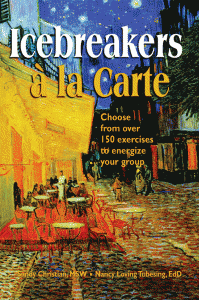Ten Principles for Choosing the Right Icebreakers

Not this kind of icebreaker! The USCG Alder, breaking ice. Duluth, Minnesota.
We all know that icebreakers are important. (OK, I do know that we all aren’t thinking of boats like the USCG Alder clearing ice for shipping.) Certainly we’ve worked with or socialized with a group of disparate folks who can’t seem to talk to one another, let alone work as a team, have a good time, or be open to therapeutic discussions. It is a given, right? Open your fill in the blank with an effective, on point icebreaker. Finding how to select the right one, however, doesn’t seem to be as easy as one would think.
These ten principles will help you make that choice.
All groups need icebreakers. The world if full of shy people who need focus and a very specific way to talk frankly about themselves. Icebreakers provide a vehicle for sharing select personal information, freeing people from constraining anxiety, and guiding participants into authentic, purposeful, often touching conversations.
Icebreakers are not just for getting acquainted. They are especially useful for groups of strangers; but even well-acquainted groups can use icebreakers to ease into a course or group discussion, provide focus for group activities, and establish the proper climate for learning. From first meetings to final farewells, icebreakers pave the way for people to be real.
Icebreakers make the group, and its members, attractive to participants. Not everyone will like everyone else in a group, but the more people are attracted to other participants, and discover common interests, goals, and values, the more eager they will be to participate. Icebreakers induce people to share in spontaneous ways that stimulate lively interaction and draw people to one another.
Icebreakers affirm the rights of participants. Everyone who joins a group has human rights: to be recognized as individual, to have input into some group decisions, to have an equal opportunity to participate in the group, to establish goals and work towards them, to have others respect personal privacy, and to have the group be a safe, secure place in which no one is belittled or degraded. Icebreakers direct participants into activities and behaviors that uphold and affirm these rights in words and actions.
Icebreakers should be relevant to all participants. Everything you do should be relevant to the culture of the group, and its members. Icebreakers, as well as other group activities, should be presented in the context of participants’ life experience and be relevant in language, values, and style.
Trust is the most important variable to consider when using icebreakers. Icebreakers help establish trust and contribute to its strength throughout the life of the group. The bottom line is, “Can I be honest here and say what I really think and feel?” If the answer is no, the group is constrained from lively, spontaneous communication and deferred in its purpose. Icebreakers remind people over and over that open, heart-searching communication is like a wind blowing the group spirit in the right direction.
Icebreakers are vehicles for shaping open group systems. The best environment for learning is an open system, one that accepts and welcomes diverse people, invites honest communication, expresses warmth and affection freely, challenges individuals to grow, shares warmth and affection freely, challenges individuals to grow, shares power with all its members, provides support for people who need it, respects personal boundaries, and honors the limits of the group itself.
Icebreakers provide a way of quickly introducing these values to the group in action and words. Since the rules of the system are often decided in the first few minutes of interaction (without ever talking about them, just by watching each other and the group leader for clues about how to behave,) it’s all the more important that icebreakers be used early on to lay the foundation for an open system.
Equal, active participation is an implicit goal of all icebreakers. Successful groups are the responsibility of all participants. The more you inform people about their choices, the more they can take responsibility for group learning. Knowing what the leader has planned, why a particular activity was chosen, and what their roles and responsibilities will be, helps group members make clear decisions about how they want to participate.
Most groups need a balance of activities. Too much of any one thing creates a lop-sided group; overly friendly, chatty groups may never get down to business, while “all work and no play” groups may suffer from boredom. Most groups function best with a mixture of activities, some light-hearted, others serious.
Experiential, holistic learning is ideal. Learning involves the whole person: mind, body, spirit, relationships and emotions. When group activities incorporate all these aspects of learning and accommodate the different learning styles of individuals, the chances are great that group members will have a complete experience, one they can integrate with previous experience and apply to everyday life, resulting in a genuine change of attitudes, perceptions, feelings, thoughts, and behaviors.
These ten principles have been taken from Icebreakers a la Carte by Sandy Christian, MSW and Nancy Loving Tubesing, EdD. 

This was an awesome and excellent contribution. There have been times when the air in a group just needed to be energized a little before a particular activity was about to be challenging. Out of the blue wrote a word relating to this forthcoming activity and used the HANG MAN approach for 2 teams to compete to fill in the missing word. No longer using Hangman as a simple fill-I- the blank works fine. Also created one on abbreviations related to jobs postings. Created three sections answers on the back of each card with the front of the card (cut up old files that are 3 different colors and decorate them for Group A, Group B and Group C). Choose a group participant to lead the activity. Have cool book marks ready as a prize for the group that earns highest score for getting the abbreviations correct.
So glad you liked the Icebreaker Principles. Looks a though you have a real handle on this tool.
Peg Johnson
Whole Person